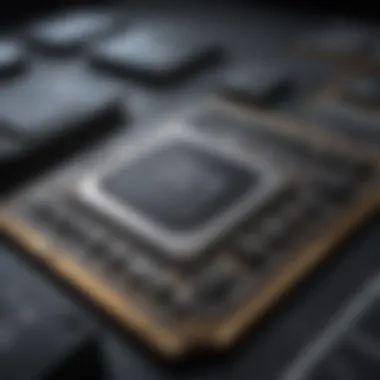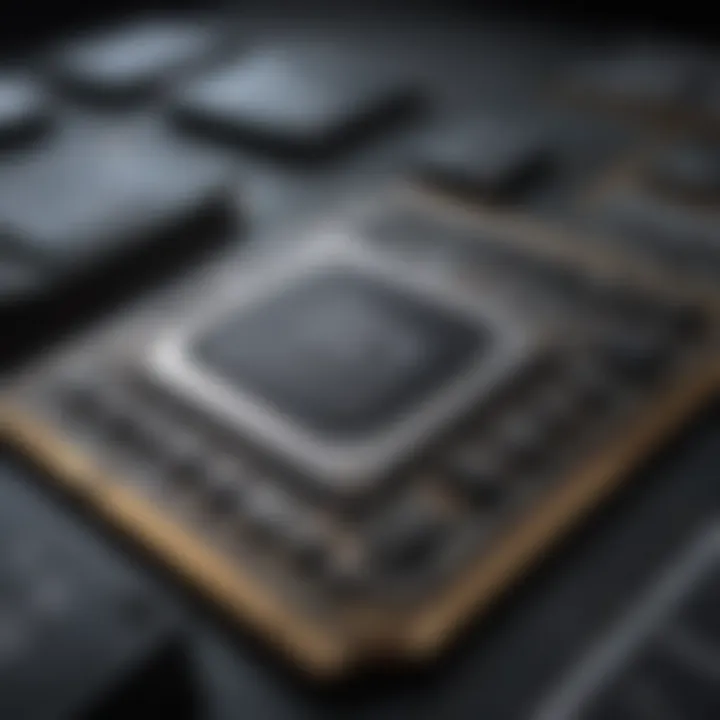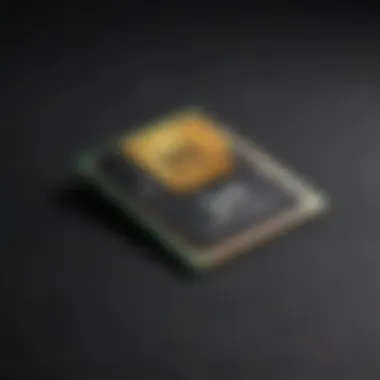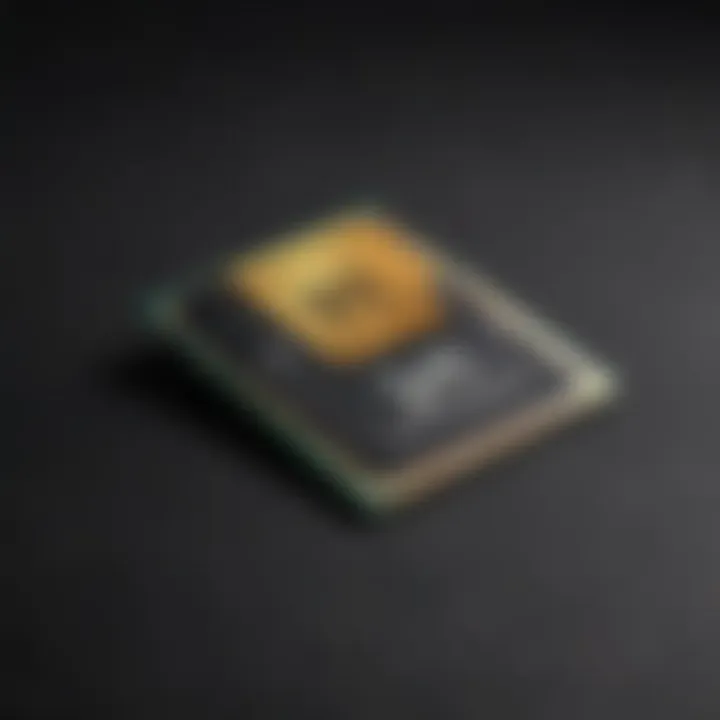Understanding 32GB RAM Cards: Performance and Compatibility


Prolusion
The increasing demand for high-performance computing has led to a significant evolution in RAM technology. In particular, 32GB RAM cards have carved a niche in various sectors, from gaming to business computing. Understanding these 32GB RAM cards is crucial for users looking to enhance their device capabilities.
This guide equips readers with the knowledge necessary to make informed decisions regarding 32GB RAM cards. Cards of this capacity are especially relevant in today's data-intensive environment, which requires adequate multitasking capabilities and a seamless experience across applications.
Product Overview
Prelims to 32GB RAM Cards
32GB RAM cards are a vital component for many modern computing needs. They provide ample space for processing large datasets or managing multiple applications simultaneously. Their adoption is prevalent among gamers, graphic designers, and professionals working in fields requiring substantial memory presence.
Key Features and Specifications
Several aspect factor into selecting the right 32GB RAM card. These include:
- Type of RAM: DDR4 is the most common version faced with these cards, as it offers a balance of performance and power efficiency.
- Speed: Standard speeds typically hover between 2133MHz to 3600MHz. Faster speeds generally translate into better performance for demanding applications.
- Number of Modules: Many users opt for pairs instead of a single module to enable dual-channel functionality.
- Form Factor: Depending on their application, these cards can come in DIMM form for desktops or SO-DIMM for laptops.
Design and Aesthetics
While primarily functional, the physical design of RAM can vary, especially in the gaming market. Some brands, such as Corsair and G.Skill, have introduced kits that come with funky heat spreaders and RGB lighting effects, which appeal to build enthusiasts.
Performance and User Experience
Performance Benchmarks
In various benchmark tests, 32GB RAM cards consistently show superior performance in tasks like video editing and graphic-intensive applications. When using benchmarks like Cinebench or AIDA64, users can observe significant throughput compared to lower capacities.
User Interface and Software Capabilities
Users with modern operating systems such as Windows 11 or the latest versions of macOS can efficiently manage 32GB of RAM. The systems optimize memory allocation for background applications seamlessly, ensuring that users achieve their desired level of performance.
User Experiences and Feedback
Feedback indicates that users transitioning to a 32GB setup experiences enhanced performance, especially in multi-tasking scenarios. Many report smoother video rendering times and faster data analysis capabilities.
Comparison with Previous Models or Competitors
Advancements and Improvements
The leap from 16GB to 32GB RAM has been significant. Many applications are now utilizing this higher capacity, allowing for more data to be accessed quickly. Evolution in RAM technologies reduces latency and enhances bandwidth capabilities, offering clear advancements over older models.
Competitive Analysis
When compared to other options, the 32GB category has substantial market presence. Competitors including Corsair, and Kingston provide a wide range of RAM with comparable specs and features. The user must weigh their budget against necessary specifications to determine the best fit.
Value Proposition
Investing in a 32GB RAM card offers strong value particularly for those engaged in demanding computing environments. The performance improvements often justify the cost when comparing to benefits within productivity boosts.
Tips and Tricks
How-to Guides and Tutorials
To maximize the use of 32GB RAM cards, users should ensure compatibility with their motherboards. Installing RAM modules should transfigure to a straightforward task as long as correct slots are used and proper attention to securing module alignment is given.
Hidden Features and Functionalities
Many motherboards provides options to tweak memory timings allows enthusiasts to increase performance further at minor stability risk. Educating oneself on what BIOS functions to utilize can lead significant gains.
Troubleshooting Common Issues
Some users may face situations where they detect performance issues. Often, dual-channel setups may not properly configured, leading to reduced efficiency—consult manufacturer guidelines can assist.
Latest Updates and News
Recent Developments
Innovations in RAM, such as the transition to DDR5, reflects advancements since 32GB will continue to be a relevant performance solution for those want to stay in premium and the scalable segment of RAM technology.


Industry News and Rumors
With new enhancements on the market, speculation surrounds the capabilities of the next generations of both DDR4 and upcoming DDR5. More manufacturers are investing in higher-speed options.
Events and Announcements from RAM Manufacturers
Lastly, RAM events often revolve around leading tech conventions throughout the year, where discussions on new products and technologies occur. Keeping a lookout for product launches can provide an opportunity for early adapters.
Understanding the role of 32GB RAM cards in today’s rapidly evolving tech landscape is paramount. Their significance extends from ordinary computing tasks to critical computing operations.
Intro to RAM and Its Importance
The realm of computing technology relies heavily on components that maximize efficiency and performance. Among these, Random Access Memory (RAM) stands as a pivotal element. RAM serves as the short-term memory of a computer, allowing for rapid access and processing of data. This article aims to dissect the intricacies of RAM, particularly focusing on 32GB RAM cards, detailing their significance in today's tech landscape.
What is RAM?
Random Access Memory, commonly referred to as RAM, is a type of volatile memory that temporarily stores data for quick access. Unlike permanent storage solutions such as Hard Disk Drives (HDD) or Solid State Drives (SSD), RAM is erased when the power is turned off. It acts as a workspace, where data that the processor needs to access constantly is stored. Without sufficient RAM, a computer struggles to process information efficiently.
RAM comes in various capacities and specifications, with 32GB being one of the notable entries in the higher-capacity realm. The presence of 32GB RAM changes the game for both casual users and professionals by enabling more data to be processed simultaneously, thereby enhancing overall performance.
Role of RAM in Computing Performance
The influence of RAM on computing performance is profound. It directly affects how quickly programs load and how many applications can be run without degrading system responsiveness. A few key points on its role include:
- Speed: RAM operates considerably faster than storage drives. Programs pull data from RAM, allowing for quicker calculations and smoother interactions.
- Multitasking: With more RAM, a computer can handle multiple applications seamlessly. For example, a system threw a graphics editing software, a web browser, and a virtual machine can operate together without lag if sufficient RAM is available. The increase in multitasking capability is particularly advantageous for professionals who work on resource-intensive applications.
- Enhanced Stability: More memory also contributes to improved system stability during intensive operations, reducing the chances of system crashes or throttle down under heavy load.
In summary, losing quality in these aspects leads to a frustrating user experience. Therefore, understanding RAM allows users to make informed decisions that align with their computing needs.
Understanding the fundamental elements of RAM lays the foundation as we delve deeper into 32GB RAM cards and their unique benefits.
Exploring 32GB RAM Cards
Overview of 32GB RAM Cards
As technology advances, the demand for memory capacity in computers has increased significantly. 32GB RAM cards emerged as a prominent option for modern systems, delivering substantial support for advanced applications and tasks. Unlike their lower-capacity counterparts, 32GB RAM cards provide room for more subprocesses. This feature becomes increasingly crucial for tasks such as video editing, 3D rendering, and large-scale data analysis.
These RAM cards also accommodate multiple demanding applications running simultaneously. The architecture of a 32GB RAM card—most commonly DDR4 or DDR5 architecture—highlights enhanced data transfer rates compared to previous standards. This means faster loading times and more efficient multitasking capabilities, leading to an overall smoother user experience.
Benefits of Upgrading to 32GB RAM
Upgrading to 32GB RAM presents decision-makers, graphic artists, and programmers with numerous advantages. One key benefit is the significant improvement in performance for intensive applications. Applications that rely heavily on RAM will notice faster operations, which is critical when handling large datasets or complex programs.
Moreover, 32GB RAM enables more effective multitasking without notable slowdowns. Users often juggle several tabs or windows at once, especially in professional environments. A card with this capacity ensures that switching between these applications occurs seamlessly. High-performance gaming can also achieve enhanced frame rates and reduced latency with adequate RAM.
In addition, the future-proof characteristic of 32GB RAM contributes to long-term usability. Many tech enthusiasts find that investing in higher-capacity RAM helps their systems remain relevant for years, accommodating the next generations of software and workloads.
Types of 32GB RAM Cards
The diverse nature of 32GB RAM cards has significant implications for performance and user experience. Understanding different types ensures users make informed choices. Highlights include the variations in speed, efficiency, and compatibility among various models. Below, we will dissect two critical types of RAM cards: DDR4 and DDR5, alongside the configurations in which they can be installed, notably single versus dual channel.
DDR4 vs.
DDR5
Overview
DDR4 and DDR5 represent the latest generations of Dynamic Random Access Memory, each bridging specific performance and capability gaps. DDR4 has been a standard since its introduction, known for its efficiency and reliability. Comparatively, DDR5 initiates substantial advancements, promising higher bandwidth and reduced latency.
Key Differences
- Speed: DDR5 provides faster data transfer rates than DDR4. On average, DDR4 offers speeds between 2133 MHz to 3200 MHz, whereas DDR5 begins at about 4800 MHz, demonstrating a marked enhancement.
- Bandwidth: DDR5 brings improvements to bandwidth efficiency, allowing multiple chips to operate effectively together. This method can significantly benefit data-heavy applications such as gaming and data analysis.
- Power Management: DDR4 relies on motherboard-level power regulation, but DDR5 integrates power management directly within the module. This design may lead to better energy efficiency.
Both DDR4 and DDR5 are not universally compatible. Manufacturers often confirm this distinction, urging buyers to check specifications meticulously.
Understanding these variances arms consumers with the knowledge to assess their needs accurately. If the utmost speed and efficiency are crucial, DDR5 might be the way forward. However, DDR4 still represents a solid choice for many.
Single vs.


Dual Channel Configuration
The arrangement of RAM in single or dual channel configurations further impacts overall system performance. Each option offers its own opportunities and potential limitations.
Single Channel Configuration
In a single-channel setup, one RAM stick is placed into a single memory slot on the motherboard. While straightforward and providing a certain degree of flexibility in terms of capacity, it does not utilize dual bandwidth. This means that the potential for optimal data transfer is limited, which can affect performance in memory-intensive tasks.
Dual Channel Configuration
Dual-channel setups, on the other hand, leverage two RAM sticks in separate channels while still maintaining synchronization. This configuration essentially doubles the memory bandwidth, allowing data to flow more freely between RAM and the CPU. Benefits visible in high-intensity applications such as gaming or video editing are often substantial. When compatible, establishing a dual channel through matched pairs of RAM is often a preferred method for upgrading.
In summary, the choice between single and dual channel RAM configurations falls squarely on user needs and intended applications. Those looking for enhanced performance in demanding environments may lean toward dual channel.
Choosing between DDR4 and DDR5 as well as the configuration is much more than simply preference. Users must consider their unique workflows, existing system specifications, and future plans. Making a well-informed decision maximizes the beneficial impact of these RAM types.
Compatibility Considerations
Understanding compatibility is key when discussing 32GB RAM cards. RAM compatibility involves various factors including motherboard specifications, existing RAM configuration, and the overall system architecture. You cannot simply add any RAM stick to a computer and expect it to work. Ensuring that the new RAM is compatible with your existing hardware is crucial for optimal performance.
Understanding RAM Compatibility
RAM compatibility is impacted by several technical elements.
- Memory Type: Make sure the RAM type (such as DDR4, DDR5) matches the motherboard. A motherboard designed for DDR4 cannot use DDR5.
- Speed: RAM comes in different clock speeds which affects performance. Often, when you install RAM with a slower speed, all RAM runs at the speed of the slowest stick.
- Voltage: Your motherboard has to support the voltage rating of the new RAM. Installing RAM with incompatible voltage can cause instability or even damage.
- Form Factor: Whether you need SO-DIMM or DIMM modules will depend on the type of system. Laptops generally use SO-DIMM while desktops use DIMM.
It's wise to consult your motherboard's manual to fully understand what specifications to adhere to when upgrading.
Compatible Devices for 32GB RAM
Various devices support 32GB RAM. However, you should confirm support capability first. Here are examples of compatible devices:
- Desktops: Most new high-end desktop motherboards from ASUS, MSI, and Gigabyte generally allow for 32GB RAM. Workstations designed for advanced applications also fit here.
- Laptops: Many gaming or professional laptops like the Razer Blade 15 and MacBook Pro effectively use 32GB RAM, কিন্তু you need to check the exact model compatibility specified by the manufacturer.
- Workstations: Designed with app developers or 3D editors in mind, workstations typically support higher RAM capacity all around.
Ultimately, gaining maximum benefits from 32GB RAM relies not just on the physical installation but also ensuring that the components can work seamlessly together.
Performance Implications
Understanding how RAM affects performance is crucial for anyone interested in optimizing their computing experience. The performance implications of using a 32GB RAM card pertain not just to capacity, but also to how it influences overall device functionality. RAM does not only store data temporarily; its capabilities dictate how smoothly applications run and respond to user commands.
Impact on Gaming and Multimedia Applications
Gaming systems highly depend on memory allocation and bandwidth. 32GB RAM proves to be a boon for modern games that are increasingly demanding in terms of system resources. It enhances both load times and frame rates.
- Many modern titles require significant memory for smooth gameplay.
- RAM impacts not only realism through detailed environments but also responsive gameplay, critical for competitive situations.
- In multimedia applications, such as video editing or graphic design, having sufficient RAM can drastically reduce render times and simplify multitasking while needing several large files loaded simultaneously.
A system running games like Cyberpunk 2077 with 32GB gives room to run background applications without fewer interruptions. Gamers transition in the environments effortlessly while other non-gaming applications operate in tandem. The influence of RAM on open-world complexities cannot be overstated here.
Improvement in Multitasking and Productivity
Utilizing 32GB RAM can greatly enhance the day-to-day tasks of both casual users and professionals. A majority of people use multiple applications at once. This includes web browsers with numerous tabs, productivity software, and video conferencing tools.
Having enough RAM enables:
- Programs to utilize a larger amount of memory for caching files and executing instructions.
- Smooth transitions between applications without lag, thus maintaining a productive workflow.
- Better handling of heavy software, such as Adobe Photoshop or development environments like Visual Studio, where individual tasks often require substantial memory.
As projects become more complex, the necessity for larger memory items escalates. Applications that hit hiccups without enough RAM can abruptly slow progress, leading to frustration. This productivity enhancement may seem trivial at first glance but is deeply essential, especially in environments that value efficiency.
"32GB RAM is no longer a luxury; it is becoming standard for power users who want optimal performance across demanding tasks."
Market Options for 32GB RAM Cards
Considering the growth in computing demands, examining the market options available for 32GB RAM cards is vital. Knowledge of these alternatives helps consumers make informed decisions, maximizing not only performance but also budget efficiency. When selecting RAM, one should think about the brand reputation, technological stability, warranties, and overall performance metrics.
Leading Brands in the Market
Several brands dominate the RAM market, offering various 32GB options tailored for differing needs, functionalities, and price ranges. Some of the prominent brands include:
- Corsair: Known for high-performance memory modules, Corsair provides excellent overclocking potential and reliability.
- G.Skill: Offers specialized RAM series designed for gamers and enthusiasts, with aesthetically pleasing designs when applicable.
- Kingston: Their HyperX series features superior heat dissipation technology, suitable for heavy multitasking tasks.
- Crucial: A solid reputation for budget-friendly options without compromising on performance.
- ADATA: Prioritizes speed and strong thermal management, targeting both casual and dedicated users.


These brands have some unique features catering to specific user bases. Hence, examining specs, compatibility, and customer feedback is necessary for selection.
Budget Considerations and Value for Money
When considering budget aspects, expenditure on 32GB RAM must align with usage expectations. Upgrading to 32GB is often an investment in better device performance. To achieve the best value for money, consider the following:
- Specifications vs. Cost: Understanding the technical specifications versus the price helps in dictating the true value of a RAM card.
- Warranty Offers: Brands may provide different warranty durations. A longer warranty indicates brand confidence in product durability.
- Compatibility Needs: Some motherboards may have specific requirements that enhance overall functionality when paired with a compatible 32GB RAM.
- Market Trends: Checking seasonal trends can reveal potential discounts. Shopping during early spring or fall usually avails more deals.
Carefully weighing the appearance of compatibility and the performance advantage can enhance perceived value. In summary, exploring the market options available for 32GB RAM cards is essential for making a smart purchasing decision that contributes to performance aim as well as budgetary outcomes.
Installation and Upgrade Process
The installation and upgrade process of 32GB RAM cards is a pivotal aspect of maximizing a system's performance. Users may wish to upgrade to 32GB for various reasons, including improved multitasking, better handling of resource-intensive applications, and enhanced gaming experiences. Understanding how to install RAM properly can help ensure these benefits are fully realized.
Additionally, upgrading RAM can breathe new life into aging devices. However, untrained individuals might take unnecessary steps or neglect essential procedures during installation. Thus, having insights into the hardware involved is crucial to avoid potential pitfalls.
Steps to Install a 32GB RAM Card
Installing a 32GB RAM card may vary based on the make and model of the computer, but the steps generally remain consistent. Here is a simple guide for a typical installation process:
- Power Down the Computer: Always ensure the device is turned off before performing any hardware changes.
- Unplug Power Cords and Peripherals: Disconnect all power cords, peripherals, and components. It will facilitate safer handling of the internal components without the risk of sudden electrical shocks.
- Open the Computer Case: Carefully remove the screws or clips that hold the side panel in place. Make sure to lay the case on a clean, static-free surface.
- Locate the RAM Slots: Identify the RAM slots on the motherboard. Take note of the existing configurations, as the new RAM may need to align with certain channels for optimal performance.
- Install the New RAM Card: Align the memory stick with the slot. The notch on the RAM card should match that of the RAM slot. Push down firmly until you hear a click, indicating that it is securely in place.
- Reassemble the Computer Case: After installation, replace the side panel of the computer case and secure it with screws or clips.
- Reconnect All Cables: Ensure that all previously disconnected cables and peripherals are correctly reattached.
- Power On the Device: Start the computer. During boot-up, you can access the BIOS settings to verify that the new RAM is recognized correctly.
Following these steps should allow for an effective upgrade.
Common Installation Challenges
Many users encounter challenges during the RAM installation process. Here are a few common issues:
- Incompatible RAM: Sometimes, the RAM may not be compatible with the motherboard or existing RAM modules.
- Seating Issues: Users may not fully seat the RAM module, leading to boot failures or instability.
- Static Electricity Damage: Without proper precautions against static electricity, components can experience damaging discharges. Always use an anti-static wrist strap or periodically touch a grounded metal object.
- Ignoring Manufacturer Guidelines: Different manufacturers might have specific recommendations for RAM installation or configurations. Not adhering to these can cause performance issues.
- Failure to Test After Installation: It is advisable to run tests using ongoing software to check for stability and performance after installation.
Awareness of these challenges aids in a more informed approach to the installation process, minimizing risks involved in upgrading RAM.
Future of RAM Technology
As the digital landscape evolves, the development of Random Access Memory (RAM) continues to be a focal point of technological advancement. This topic is crucial because RAM influences various aspects of computing. It determines system responsiveness, application performance, and overall user experience. The future of RAM technology is expected to bring significant improvements that can impact both everyday users and professionals alike. Understanding these aspects can help consumers and businesses make informed decisions, ensuring that they remain at the forefront of technology.
Trends in RAM Development
The first trend worth noting is the rapid shift from DDR4 to DDR5 RAM. DDR5 offers higher data rates, increased capacity, and improved power efficiency. Many modern motherboards now support DDR5, and few high-end devices already utilize it. This development promises enhanced performance for gaming, data-intensive tasks, and content creation, appealing to professionals and enthusiasts.
Key Characteristics of DDR5:
- Higher Density: Enabling modules to hold more memory traces.
- Improved Speed: Starting at 4800 MT/s, whereas DDR4 typically starts at 2133 MT/s.
- Lower Power Consumption: Operating at 1.1V compared to DDR4's 1.2V.
Another trend involves the growing popularity of LPDDR (Low Power Double Data Rate) memory. This type of RAM is used primarily in mobile devices, as it provides improved battery life without sacrificing performance. It's now being adopted in ultrabooks and tablets, emphasizing energy efficiency in performance-driven applications.
A third important trend is the exploration of 3D Stacking Technology. This approach aligns memory chips vertically instead of horizontally, which can significantly minimize latency while maximizing performance. Manufacturers are experimenting with this technology mainly for high-performance computing (HPC) and artificial intelligence applications.
Overall Trends:
- Transition to DDR5 in core computing.
- Increased adoption of LPDDR for mobile compatibility.
- Experimentation with 3D stacking for future-ready RAM technologies.
The Prospect of Higher Capacity RAM
In response to the growing demands for speed and efficiency, the expectation around higher-capacity RAM is undeniable. Systems today increasingly require more RAM to handle intensive applications, particularly in creative fields such as video editing and 3D rendering. As a direct result, manufacturers are investing in the development of larger capacity modules, pushing past the 32GB threshold.
According to industry forecasts, by the mid-2020s, we may see consumer-level PCs equipped with 64GB or even 128GB RAM as standard in high-end models.
This expansion leads to several crucial benefits. Firstly, larger RAM sizes enable smoother multitasking. Users can run more applications simultaneously without experiencing slowdowns, which is vital for productivity and efficiency. Additionally, for gamers, the increased capacity ensures that memory-intensive games can run seamlessly, improving overall performance and providing a better experience.
As computing configurations evolve, the rise of non-volatile RAM is also on the horizon. This memory type retains data even when the power is off, drastically changing how data is stored and accessed. Such capabilities will certainly advance alongside emerging technologies like machine learning and blockchain, each of which require significant processing power.
In integer, the future of RAM technology is filled with promising developments that cater to an evolving computing environment. Users must stay informed and adapt to these changes to make time-after-evaluation decisions about their computing demands. The drive toward higher capacity RAM, new formats, and innovative designs shapes what both consumers and industry professionals can expect from the years to come.
End
In wrapping up this comprehensive exploration of 32GB RAM cards, it is essential to underscore their significance in modern computing environments. As technology evolves, the demands placed on hardware continue to grow. This makes 32GB RAM not just an upgrade, but often a necessity for those wishing to optimize their computing experience.
Summarizing the Importance of 32GB RAM
32GB of RAM provides a substantial performance boost, particularly for tasks requiring high memory usage. This applies to areas like gaming, video editing, and 3D rendering. Here are some key points about the importance of investing in 32GB RAM:
- Enhanced Multitasking: More RAM allows for multiple applications to run smoothly at the same time, without lag. This is crucial for programmers, content creators, and professionals utilized to manage numerous tasks concurrently.
- Compatibility with Future Software: As software evolves, their demands on system resources typically increase. A 32GB RAM cards can prolong the lifespan of a device by keeping it relevant as newer software versions arise.
- Improved System Performance: Users often report less clutter and more agile system responses when using higher-capacity RAM. This results in a much more seamless experience across the board.
Furthermore, the consideration for upgrades, exchanges, or installations becomes critical for both individual users as well as corporate entities with significant IT budgets. This pattern observed in technology indicates 32GB RAM can pave way for a head start towards greater productivity and performance in various fields.



